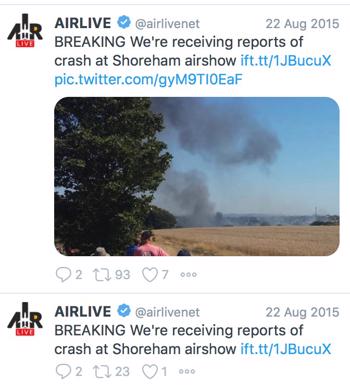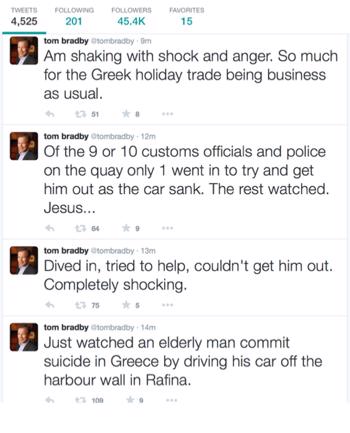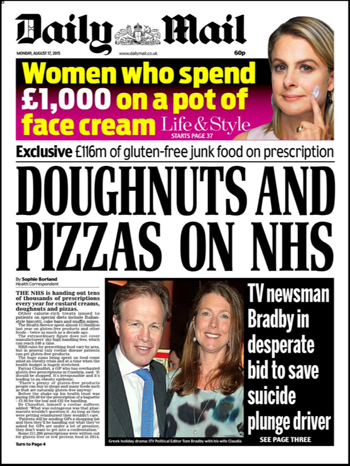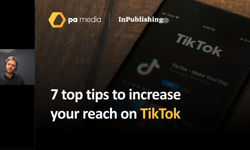
I once asked a national newspaper news-editor what he wanted from his reporters. Three things, he replied. One, to write accurately and in style; two, bring in story ideas and, three, smile. "I don't want to be surrounded by miserable bastards." All great advice. Point number two struck a particular chord with me.
When I was a trainee, it was drummed into me that the best reporters never have an empty notebook. When slow news days happen (think Boxing Day or a quiet Tuesday in the silly season), reporters need to magically whistle-up cracking tales. Ideas are our lifeblood. They are particularly critical to Sunday newspapers. All those stories from the beginning of the week are dead in the water by the time the weekend comes around.
The noise on Twitter, Facebook, Instagram and the like, however irritating it can often be, simply cannot be ignored.
Story sources
I still run training sessions on how to find stories. They look at excellent content from traditional routes – contacts, classified advertising, follow-ups from local papers, magazines, experts, the diary and anniversaries. In the last decade, though, another dominant source has been added to the mix – social media. The noise on Twitter, Facebook, Instagram and the like, however irritating it can often be, simply cannot be ignored. It crackles with story ideas and leads.
When trainees on my courses head off on placement to, say, Dublin, they will all have their Tweetdecks loaded with dozens of columns – Varadkar, GAA, Irish Independent, LovinDublin, Temple Bar and more.
Ian Walker, MailOnline executive editor, is also a Tweetdeck advocate. All his team have their deck running with the handles of people likely to provide stories. He says: "Trump has set the precedent. World policy is now announced on Twitter! Just look at the row between Rebekah Vardy and Coleen Rooney. It was all played out on Twitter. There is now a likelihood that if a showbiz agent is asked for a comment, the response will go out on Twitter rather than in a straightforward reply.”
I have a sackful of stories that were found through Tweetdeck. One was from 2015 when a tweet popped up from Tom Bradby, then political editor at ITN, which said: “Just watched an elderly man commit suicide in Greece by driving his car off the harbour wall in Rafina.” His next tweet said: “Dived in, tried to help, couldn’t get him out. Completely shocking.” Bradby said he was shaking with shock and anger.
I rang the newsdesk and it was a story and front-page picture in the next day’s Mail. The first I heard of the Shoreham air crash was the tweets that appeared on @AirLivenet. The story broke on the news channels 40 minutes later.

Trump has set the precedent. World policy is now announced on Twitter!
Inside knowledge
Sam Greenhill, chief reporter at the Daily Mail, also uses Tweetdeck but goes a step further. He sets up a list (select new column and create new list) of the Twitter users who have inside knowledge. He says: "I made a Jihadi list when reporting on terror attacks. The users included Frank Gardner, always a great source of insider knowledge, and some academics who monitor the Jihadi world.
"When covering the Government’s (extremely complicated) Supreme Court battle over prorogation, my list included legal experts who tweeted the best running analysis.”
Even those reporters who are wary of social media as a source, will trawl Facebook and Twitter for witnesses once a story breaks. It is where the first-hand accounts, the videos, photos and the human stories are found.
When the London Bridge attack happened in November, when Grenfell Tower went up in flames, when the Manchester Arena bomb went off in 2017 … journalists immediately scoured Facebook and every search imaginable was set up on Tweetdeck.
Paul Morgan-Bentley, head of investigations at The Times, tends to use social media for detailed research rather than sourcing stories.
He says: "Social media is a really useful way of finding people. On an investigation into Action Fraud, the police reporting service, I found current and former employees through Facebook and LinkedIn. I didn't approach them immediately as I worked there undercover and did not want to risk exposure but approached some afterwards.
"One of the current staff used his Twitter account to insult fraud victims and wrote of being drunk at work. When I went to work there, I could then identify him and it turned out he was one of the managers. I wouldn't have got that line had I not built up backgrounds using social media beforehand.”
It is still incredibly easy for people to appear as someone they are not.
Picture library
Twitter, Facebook and Instagram have also become essential tools for finding pictures. Walker is particularly keen on Instagram: "In the old days, a reporter’s job was to look for ‘collects’, pictures of people in the news whether for good or bad reasons. Heroes, criminals, victims or lottery winners, the need for images to support the words meant a visit to relatives, place of work or old school. Now, most people have an online identity. And they will almost certainly have a presence at where they work or where they were educated. Finding those links can be key to building the best possible story – and illustrating it.”
It isn’t just the newsdesk that uses social media. Femail’s Steph Linning, at MailOnline, rattles off an assessment of each platform: "Instagram for photo-led celebrity and society stories; Facebook for hacks; Twitter for television reaction, viral threads and talking points; Reddit for anonymous stories (wedding shaming is a popular sub-genre)."
Morgan-Bentley also thinks different platforms have different strengths – Facebook to build up family trees, confirm identities and for pictures, Instagram for pictures, LinkedIn for finding people who previously worked at a company he might be investigating and Twitter for a little bit of everything.
It is clear that social media as an essential source is here to stay … but there are huge pitfalls.
It has become ever-more critical that everything is triple-checked.


Journalists have always needed to verify the facts. When print was king, we had time to validate and hold off if there was any uncertainty. In the digital world of immediacy, there is not only more content around but there is also more fakery and more pressure to publish quickly. It has become ever-more critical that everything is triple-checked. That was never more evident than after the Manchester Arena bomb. Rob Irvine, editor of the MEN at the time, says: "Some weird and frankly horrible people saw fit to publish on social media fake or entirely unrelated images of missing people. I saw these appear on some reputable news websites."
Not-checking can be hugely damaging, hurtful and is, at best, irresponsible.
It isn't just news that needs to tread gingerly. Olly Todd, sports editor at MailOnline, warns: "Be careful. Without additional verification systems, it is still incredibly easy for people to appear as someone they are not. Never rely on a Twitter, Facebook or Instagram account as your only source.”
It is a view shared by Martin Belam, senior social reporter at The Guardian: “Verification is a massive problem when journalists use social media as a source. People go to great lengths to verify if footage of a terrorist incident is genuine.
"But people do a lot less due diligence if they are writing ‘fans outraged as Game of Thrones / Doctor Who / Marvel movie does X'. Are these really fans?
"If you look on Facebook under any official Doctor Who post these days, you’ll find people saying, 'I don’t watch it now the Doctor is a woman and it is full of social justice warrior nonsense'. Click on the profiles and often they are people wearing MAGA hats and promoting 2nd amendment gun rights and memes against abortion and trans people. Are they really fans of British sci-fi / fantasy television – or following a 'culture war outrage' script?
"Journalists need to exercise caution about amplifying views deliberately posted on social media to attract outrage.”
There are other pitfalls too – not least copyright. It is tempting to lift photos and videos, particularly in a fast-moving story. But don't be surprised if someone comes after you for a fee.
Belam has another concern: "I worry about social media polluting the news. That we write about stupid stuff and it produces a feedback loop that people do more stupid stuff to get attention.
"But, as much as you might criticise articles like 'This thing happened on social media and here are 15 jokes about it', we can also see from the metrics that these are read and enjoyed.
"Sometimes, a round-up of jokes or an explainer about why you are suddenly seeing the same meme photo all over your timeline, can be informative to an audience who want news and entertainment."
Social media has made itself an essential tool for the journalist … but it clearly needs to be used professionally. There is a mass of stuff out there – opinions, photos, videos – but it is a minefield. Verification, triple-checking and being sceptical about everything have always been essential qualities in a journalist.
When I started as a trainee reporter, my news-editor told me in no uncertain terms: “Your job is to confirm things. If you can’t, try harder. If you really can’t, we won't publish”. It strikes me that that advice from 40 years ago is even more relevant now than it was then.
Journalists need to exercise caution about amplifying views deliberately posted on social media to attract outrage.
Social media tips
- Add Facebook, Twitter, Instagram, Reddit, Snapchat and LinkedIn to your armoury
- Create a Tweetdeck and update it for each story
- Make lists of experts
- Trawl for witnesses and opinions
- Don't rush to publish without verifying
- Take nothing at face-value. Check for vested interests. Trust no-one
- Contact sources by phone and interview them
- Choose your words carefully making contact – just as you would on a doorstep
- Apply the scrutiny you would to any other story
- Ask for information and permission
- Think copyright when lifting pictures and video
This article was first published in InPublishing magazine. If you would like to be added to the free mailing list, please register here.












